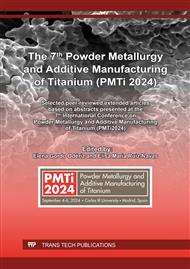[1]
Titanium Powder for Additive Manufacturing in 2023, A Custom Research Study, 3DR Holdings, (2024)
Google Scholar
[2]
Dr Q (Y.H. Chiou), A year of change: Turbulence in China's MIM industry as markets evolve, PIM International, 18 (2024), 1, 69-77
Google Scholar
[3]
X. Goso and A. Kale, Production of titanium metal powder by the HDH process, Journal of the South African Institute of Mining and Metallurgy 111.3 (2011), 203-210
Google Scholar
[4]
Ryohei Kumagae et al., Study on the Operation Practice of Plasma Rotating Electrode Process (PREP), Journal of the Japan Society of Powder and Powder Metallurgy, 43 (1996), 7, 907-912
DOI: 10.2497/jjspm.43.907
Google Scholar
[5]
P.G. Tsantrizos, F. Allaire, M. Entezarian, U.S. Patent 5,707,419 (1998)
Google Scholar
[6]
S. Pleier et al., EIGA - An innovative production method for metal powder from reactive and refractory alloys, In: International conference, Powder metallurgy and particulate materials, 2004. 2-49
Google Scholar
[7]
M. Hohmann and S. Pleier, Production methods and applications for high-quality metal powders and sprayformed products, Acta Metall. Sinica, 18 (2005), 1, 15–23
Google Scholar
[8]
M. Entezarian et al., Plasma atomization: A new process for the production of fine, spherical powders, Jom 48 (1996), 53-55
DOI: 10.1007/bf03222969
Google Scholar
[9]
W. Kroll, Patent DE674625C (1939)
Google Scholar
[10]
Chunxiang Cui et al., Titanium alloy production technology, market prospects and industry development, Materials & Design, 32 (2011), 3, 1684-1691
DOI: 10.1016/j.matdes.2010.09.011
Google Scholar
[11]
A. Gonchar et al., Development of a technology to produce titanium powder with a low carbon footprint, Eastern-European Journal of Enterprise Technologies, 122 (2023), 12, 42–54
DOI: 10.15587/1729-4061.2023.276746
Google Scholar
[12]
A. Brodskyy et al., U.S. Patent 11,440,096 (2022)
Google Scholar
[13]
A. Brodskyy et al., Patent of Ukraine No. 127000 (2023)
Google Scholar
[14]
R. Vert et al., Induction plasma technology applied to powder manufacturing: Example of titanium-based materials, Key Engineering Materials 704 (2016), 282-286
DOI: 10.4028/www.scientific.net/kem.704.282
Google Scholar
[15]
Jun-ll Song et al., Compaction behavior of bimodal iron nanopowder agglomerate, Powder technology, 338 (2018), 333-341.
DOI: 10.1016/j.powtec.2018.06.041
Google Scholar
[16]
H. Zhang et al., Improving an easy-to-debind PEG/PPC/PMMA-based binder, Polymer, 262 (2022), 125465
DOI: 10.1016/j.polymer.2022.125465
Google Scholar
[17]
M.D. Hayat et al., Modification of PEG/PMMA binder by PVP for titanium metal injection moulding, Powder technology, 315 (2017), 243-249
DOI: 10.1016/j.powtec.2017.04.004
Google Scholar
[18]
S. Guo et al., Powder Injection Moulding of Pure Titanium, Rare Met., 28 (2009), 261-265.
Google Scholar
[19]
Hayat M. D. et al., A novel PEG/PMMA based binder composition for void-free metal injection moulding of Ti components, Powder technology 382 (2021), 431-440
DOI: 10.1016/j.powtec.2021.01.009
Google Scholar
[20]
A. Dehghan-Manshadi et al., Metal injection moulding of titanium and titanium alloys: Challenges and recent development, Powder Technology, 319 (2017), 289–301
DOI: 10.1016/j.powtec.2017.06.053
Google Scholar
[21]
Zhao, D. et al, Trace Carbon in Biomedical Beta-Titanium Alloys: Recent Progress, JOM, 67 (2015), 2236–2243
DOI: 10.1007/s11837-015-1590-6
Google Scholar



